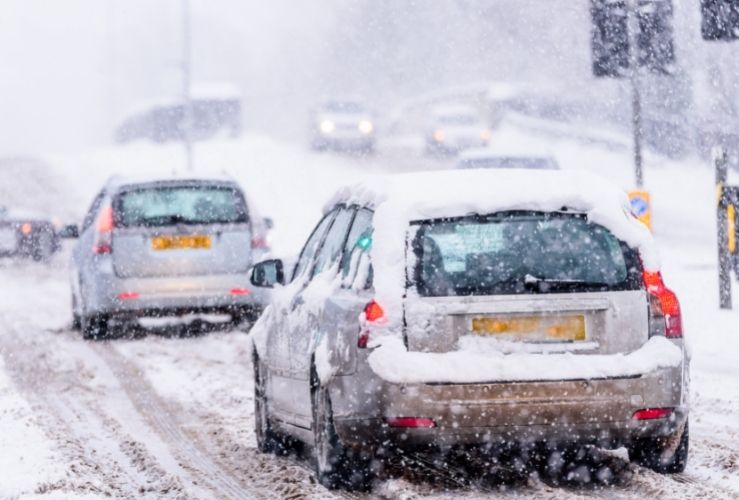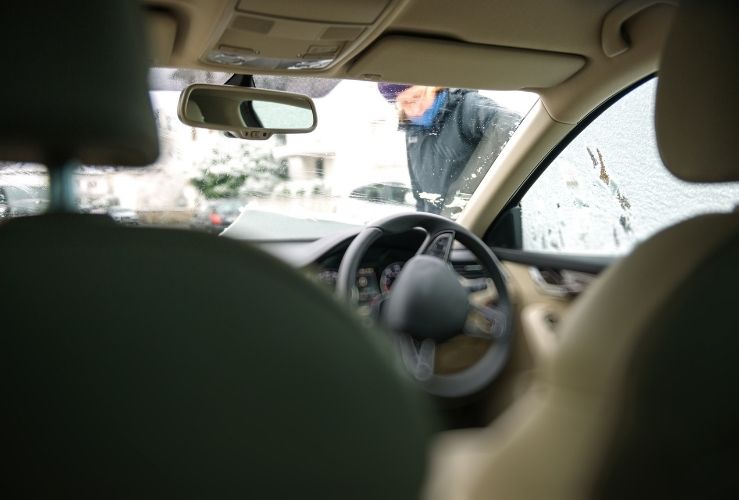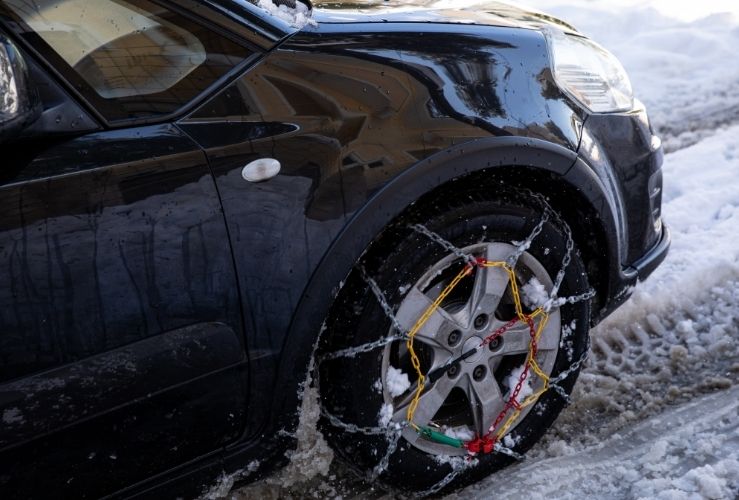Driving in snow demands extra preparation - both in terms of your vehicle and your approach to driving.
In this article we'll discuss how to drive in snow - minimising your chances of getting stuck or even having an accident.

Before you set off:
Plan your route
It's critical to familiarise yourself with your route before setting off.
Be aware of any parts of your journey that will be more exposed to inclement weather - particularly if there's a higher risk of flooding. Snow and ice may lie for longer in areas shielded from the sun, e.g. bridges and narrow passes.
As well as keeping up to date with the weather forecast, it's important to know about any traffic congestion immediately before you set off.
Allow extra time for your journey when driving in snow
You'll need more time to prepare for your trip. Clear away snow and ice from your windscreen, mirrors, lights and roof.
Driving on public roads with a layer of snow on your vehicle presents a hazard to other road users - and could get you in hot water with the law. If an officer sees snow on your vehicle or sees it fall onto the road, they could give you a £60 penalty and three points on your licence.
A clear view is critical for safe winter driving. Pay special attention to your windscreen. Use de-icer to remove any ice on the exterior of the glass, and ensure condensation has been cleared from the interior.
You can clear condensation by:
- Using the vehicle's climate control/demist function (if there is one)
- Direct the water towards the windscreen - starting off cold and gradually warming up.
- Dry out the atmosphere by turning on the air conditioning
- Roll down the windows if you do not have air con
Tip: cleaning your windscreen with shaving foam creates a protective barrier that reduces misting.
It's also a good idea to take some lock de-icer with you in case your locks freeze up during your trip.
Alternatively, you can use an oil-based lubricant for the task, or try warming up your key before insertion.

Wiper check
To avoid damaging your wiper blades or blowing the control fuse, ensure your wipers are turned off before you turn on the ignition. Wipers will be critical in keeping your view clear on the road.
Tyre check
It's always important to ensure your tyres have adequate tread depth - but even more so in snowy or icy conditions.
In the UK, the legal minimum tread depth for car tyres is 1.6 millimetres, across the central ¾ (75% of the tread around the full circumference).
If you live in an area prone to heavy or prolonged snowfall, you might consider fitting winter tyres to your vehicle. You may even think about investing in snow socks or snow chains to give you more grip (see below).
Screenwash check
Check and top up your screenwash.
It's worth investing in a high quality wash that can handle temperatures of minus 35 Celsius - ensuring the screen wash does not freeze. However, a minus 10 Celsius screenwash is likely to be sufficient for UK winters.
Be ready for extreme scenarios
Pack the following so you're ready for almost anything:
- mobile phone: ensure your breakdown provider's details are stored inside. This is among the most important items to bring while driving in the snow.
- mobile phone charger
- demisting pad
- torch (ideally wind up so there are no battery problems)
- blanket
- food and drink
- extra screenwash
- de-icer
- ice scraper
- map (paper as well as digital)
- first aid kit
- warning triangle
- jump leads
- shovel
- piece of carpet/heavy cardboard for if you get stuck in ice or snow; this can be used to give you traction.
Tips for driving in the snow
- Ensure your footwear is comfortable, dry and securely fitted
- Move of gently using low revs then swiftly change to higher gears
- You can minimise wheel slippage by moving off in second gear. 'Winter mode' will do the same job
- Maintain a larger gap between you and the vehicle ahead - aim for ten times the distance you would normally leave. This will make it easier to reduce speed/stop in an emergency
- Drive at a safe speed
- When moving uphill leave lots of space ahead of you so you can keep at a constant speed without needing to change gear
- When travelling downhill stay in a low gear, and avoid breaking unless you need to; once again, leave plenty of space between you and the vehicle ahead
- Handle bends by braking before turning the steering wheel. Don’t panic if you lose grip; take your foot off the accelerator and ensure your wheels are turned in the direction of intended travel
- In the event of a skid, gently turn into it. E.g. if the vehicle's rear is sliding left, steer to the left. Keep your hands on the steering wheel and avoid heavy braking
- Use dipped headlights in heavy snow. Daytime running lights are insufficient since they do not necessarily illuminate rear lights
- Turn on your fog lights if visibility falls below 100m (328ft). Do turn them off once visibility improves, because they create unnecessary glare in normal conditions which can dazzle other road users
- Take care when driving in other vehicles' tracks, particularly on ungritted roads - since the compacted snow will be more icy than freshly-laid snow
- Operate brakes, accelerator, steering and gears slowly and steadily
- Wear sunglasses if snow glare is excessive (especially when sun is low)
- Allow more time for braking and steering, and keep your speed low
- Be aware that areas shielded from the sun may be icier for longer. For example, bridges freeze up earlier and thaw later than more exposed areas
Rear wheel drive in snow
When it comes to winter driving, rear wheel drive vehicles are less effective than front wheel drives. However, for a country like the UK, where prolonged and heavy snow is uncommon in most areas, this will be less of an issue.
Because in most cases rear wheel drive vehicles have less weight over the drive wheels (compared to four wheel drive or front wheel drive), accelerating on icy or snowy surfaces can be more difficult. Losing control of the rear is also more likely.
For those who live in high, open areas like the Scottish Highlands, or national parks like Snowdonia, Dartmoor or the Lake District, owning a front-wheel-drive vehicle will make it easier to navigate heavy snowfall.
Protecting your vehicle from grit
Grit used on roads can adhere to your vehicle and cause corrosion.
Regular cleaning throughout the winter months can minimise this problem.

Getting a grip: Winter tyres, snow socks or snow chains?
In countries where snow is heavier and lies for longer - such as Norway and Sweden - investing in winter tyres, snow socks or snow chains is more common than in the UK. But these products can also prove useful for Britons during winter, making driving easier and safer.
But which is right for you?
Winter tyres
- These special tyres offer extra grip in snow, rain and ice
- While improving handling and performance they may be insufficient for deeper snow
- Not a legal requirement in the UK (unlike Norway and Sweden, for example, where they must be fitted during winter)
Snow socks
- Cheaper than winter tyres
- Easier to fit than snow chains
- Good for sudden unexpected snowfall/getting out of snow-covered driveways
- Must be removed when conditions return to normal
Snow chains
- The best option for deep snow
- Must be removed when conditions return to normal since they can damage your vehicle and the road surface.
- Take longer to fit than snow socks
- If you're planning to take your car on a skiing holiday to certain countries, you'll need to have snow chains in your vehicle by law
- In some rural areas of the UK with high, open roads and less regular gritting, snow chains could be the difference between completing your journey and getting stranded by the road.
Snow chains: key points
- Snow chains can be fitted to most vehicles
- Check your vehicle's handbook before fitting them
- They can be fitted by one person
- Fit chains to the drive wheels or they will have much less effect
- If you have 4WD, fit chains to the front wheels for more steering traction. Some 4WD handbooks recommended fitting them to all four wheels
- For safety, be sure to put the vehicle in gear, apply handbrake and turn off the engine
- Different snow chains have different fitting methods; read the instructions or consult the retailer
- When driving with snow chains, do not exceed 30mph. Acceleration and braking should be done gently
- Your handbook may recommend turning off traction control
- Removal generally follows the process of fitting, but in reverse
- Clean off snow and ensure there are no twists in the chains before storing away
Snow socks: key points
- Textile liners for tyres that improve grip and traction
- Easier and quicker to fit than regular snow chains
- Quieter and more comfortable than snow chains
- Not sufficient for heavy snow
- Great for getting out of snow-covered driveways
- Must be fitted to the drive wheels
- Handy to keep in your boot
- Must be removed when road is clear




